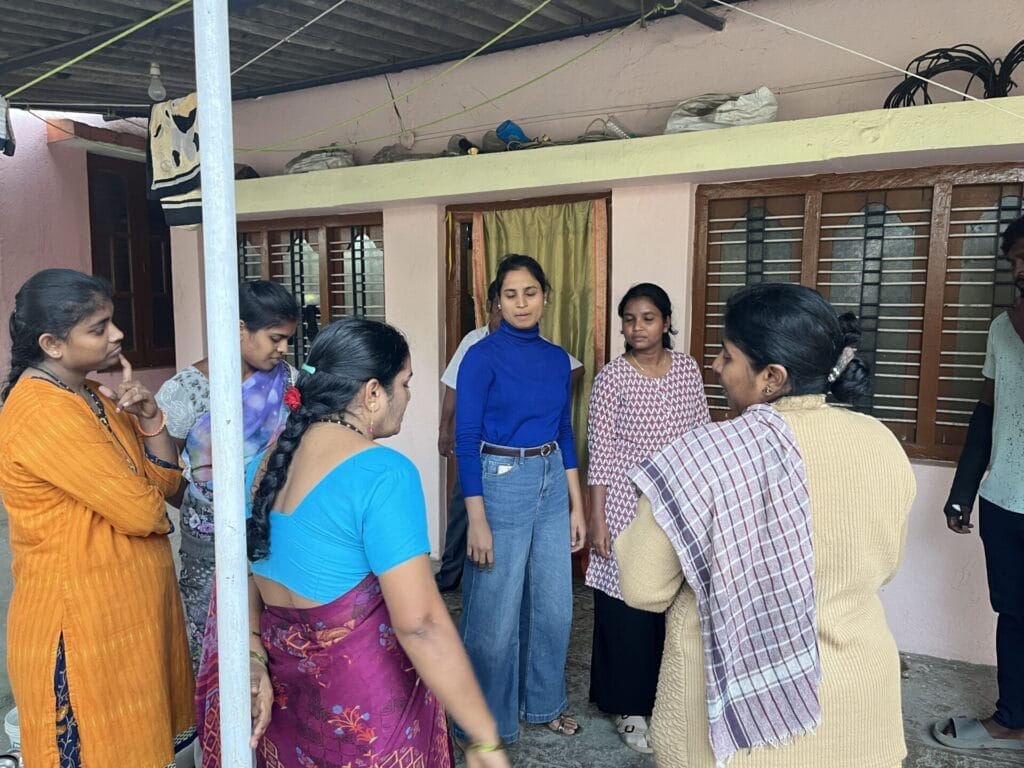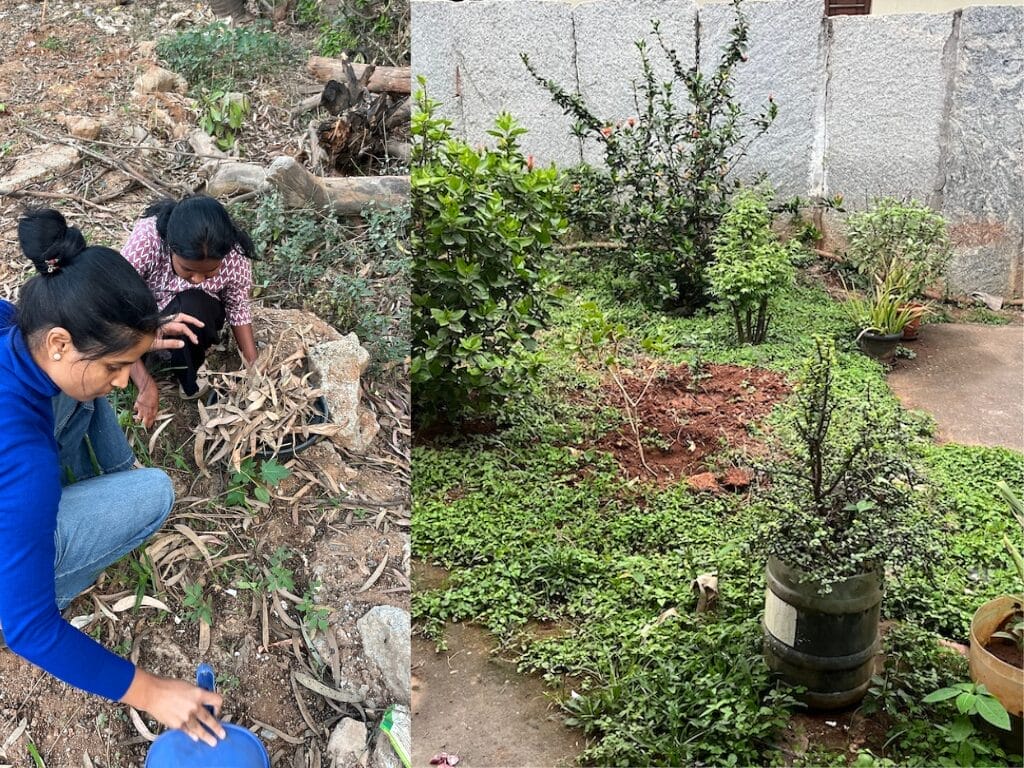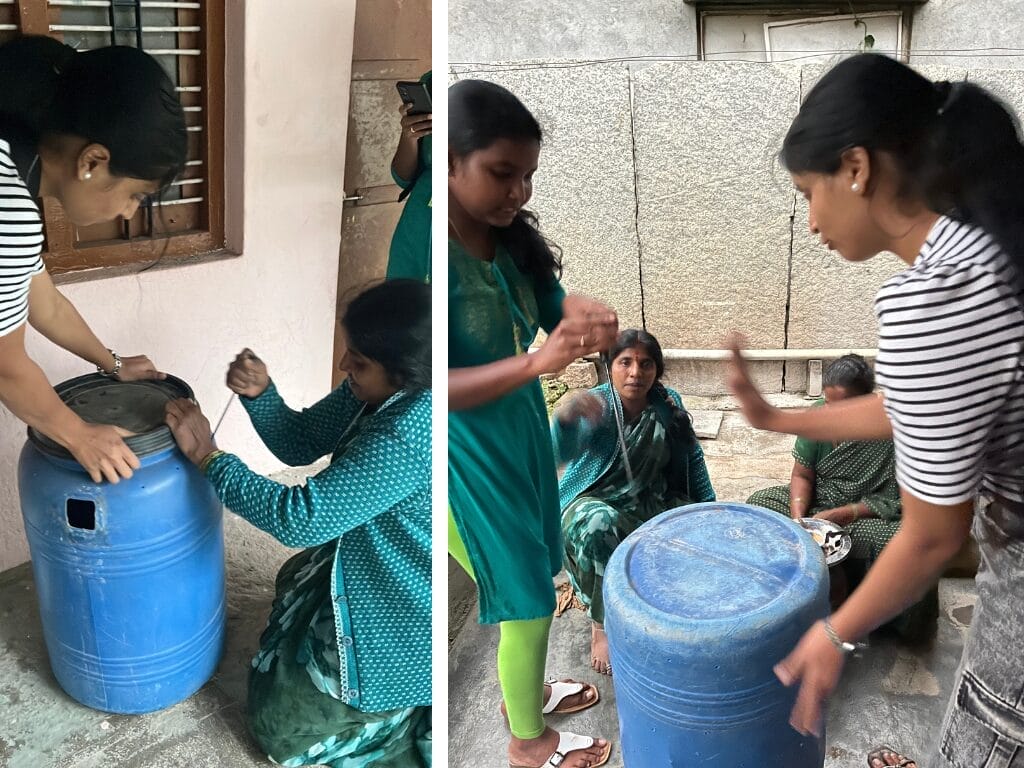In a quiet corner of Buragunte village, a transformation has been taking shape — one that turns kitchen waste into nourishment for the land and, in turn, provides food for the families of the women who made it happen. What started as a simple conversation has now evolved into a collective effort, spearheaded by one determined woman, Lalitha Akka.
Residents of Buragunte village under Anekal Taluk in Sarjapura, had long followed the waste disposal practice most commonly observed in our cities and towns — they would simply hand over their mixed waste to the collection vehicle from Billapura Gram Panchayat, under which the village falls. This vehicle then transported the waste collected to a landfill, where it was either dumped or burned.
The open dumping and burning caused environmental pollution, affecting air quality and contaminating the surrounding land and water sources. But as in most other places, residents were largely unaware of the long-term consequences of their waste disposal practices.
At the Azim Premji University (APU), while studying waste practices in the peri-urban village, our aim was to shift the responsibility of handling waste from the state to waste generators. In collaboration with Hasiru dala and the Billapura Panchayat, researchers, along with APU intern Akshaya, tried to engage with the village women to help them adopt more sustainable and environment-friendly waste management practices.
But while the awareness sessions exposed the women to the concept of waste segregation and composting, it was challenging for them to find the time and collective will of the village to implement the same. They understood the importance of these practices, but their demanding work schedules and the lack of a shared platform for discussion created a barrier to action.

Read more: How a community initiative is working towards a cleaner Elephanta Island
Persistence pays
Meanwhile, Akshaya had been attempting to get the women together to talk to them individually to get them to start composting in practice. Workshops and early morning visits proved ineffective, as the women were often preoccupied with their daily routines. Evenings seemed more promising, but repeated attempts were met with polite but firm refusals. Till a chance encounter changed everything.
One day, as she stood outside the house of Jyothi Akka, a resident of Buragunte, the latter’s daughter, who studies at the local Azim Premji School, recognised Akshaya. She ran inside and convinced her mother to come out and speak with Akshaya. This seemingly small moment became a turning point.
Akshaya seized the opportunity and gathered a group of 8–10 women for an impromptu composting session. Key among them were Lalitha Akka, an Anganwadi teacher in her 40s, and three other women to whom she had rented a part of her premises — Pyarima, Rajiya and Shahina.
The session resonated deeply with them, particularly when they saw images and videos of overflowing landfills and discussed the plight of waste pickers. That, and the image of 50 kg of plastic removed from a cow’s stomach, prompted the women to reflect on the unseen impact of their daily waste on people, as well as the animals they saw roaming their streets every day. It was not just about pollution anymore — it became personal.
Collective action
Inspired by the session, Lalitha Akka, Pyarima, Rajiya and Shahina decided to act on their new-found knowledge. They were neighbours sharing a front veranda and a backyard adjacent to their houses. Lalitha Akka had an unused drum, which they cleaned and set aside for composting. They discussed the challenges they might face, raising concerns about potential stink, the types of dry waste to use, and most importantly, what they could do with the compost they produced.
Pyarima proposed a solution that resonated with everyone: transforming the backyard, currently a mix of wildflowers and other uncultivated plants, into a thriving vegetable garden. They collectively decided to use the compost to fertilize the backyard and cultivate the land. This would not only provide them with chemical-free produce but also create a shared sense of ownership and responsibility.
Everyone was enthusiastic about the idea, marking a significant shift in their mindset. Composting was no longer just about reducing waste—it was about food security, health, and community empowerment. Growing homegrown, affordable quality vegetables in their own backyard for the family was one of their biggest motivations to practise composting.

Read more: How the people of Kannamangala are setting an example in sustainable waste management
Overcoming practical challenges
Setting up the composting drum, however, still required effort. It required another week of gentle persuasion from the APU team to convince the women to drill the necessary holes in the drum.
Finally, after two days of collecting kitchen scraps and dry leaves, the women, under Akshaya’s guidance, successfully started their first batch of compost. The initial hurdles had been overcome, and the women of Buragunte Village had embarked on a journey of sustainable living, transforming their backyard and their lives, one compost bin at a time.
Forty-five days later
A follow-up visit revealed the positive impact of their efforts. Initially, the women faced several challenges — from finding a suitable drum to the tedious task of drilling holes. However, Lalitha Akka, who spearheaded the effort, now spoke of the satisfaction she derived from the entire process.
The initial frustration over challenges was now replaced by a sense of accomplishment and ease. The women felt personally accountable for their waste and were eager to continue composting and using it for their kitchen garden. Pyarima, Shahina, and Rajiya, who had previously discarded waste carelessly, were now diligently collecting and depositing their kitchen waste into the composting drum. Cooked food waste, considered sacred, was given to a local vendor for feeding cows.
Not just these women, but several others in the village have also started community composting, following the example set by the former and spurred to action by the door-to-door awareness campaigns run by the team.

The next level: Spreading awareness
Lalitha Akka’s enthusiasm even inspired Pyarima to share her composting experience with her colleagues at the Chambebahalli apartment complex, where she works as a house helper. While her colleagues showed interest, they raised a valid concern: “What could we do with the compost if we don’t have gardens or plants?”
This question motivated Lalitha Akka to think about how she could communicate the benefits of composting, even for those without green spaces. She told them about the cleaner surroundings and shared the idea of selling compost for extra income. She pointed out that composting took barely five minutes a day — just adding kitchen scraps, dry leaves, and mixing once a week. In exchange, they were helping the environment and reducing their mixed waste.
While it may take a few more weeks to help these women fully understand the wider environmental impact of composting, the story of the women of Billapura is a powerful example of how community-driven initiatives can create lasting change. They have demonstrated the transformative power of small, collective steps toward a more sustainable world. Their journey serves as an inspiration for others to embrace such practices and work towards a greener future.
Hi, can a similiar programme be run in my layout to educate the people here in my layout in Kithaganur panchayat limits in Bangalore
It’s an excellent initiative against waste products. I thanks to all the community members for saving the environment from garbage and pollution.
I want to know the concepts on which it works. Can you please share your address so that we could visit the site and take knowledge.